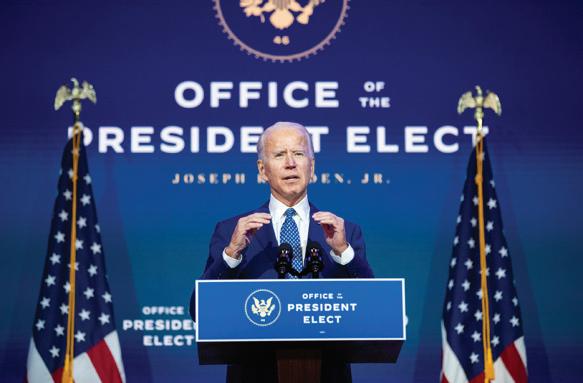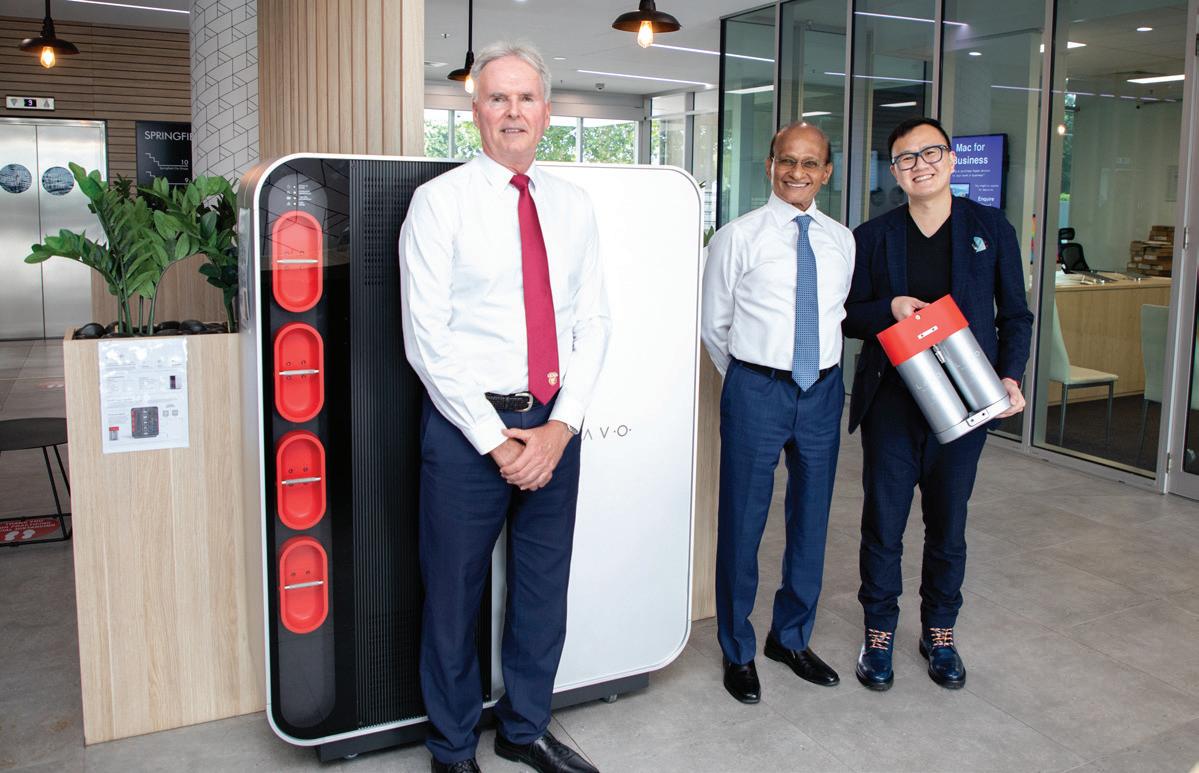April 1-15, 2021 - Vol 1, Issue 19
INDIA NEWS
MAKE IN INDIA
Make In India: Dashboard on ‘Flow of Foreign Direct Investments from top 50 countries into India 2014-20’ The investment climate in India has improved considerably since the opening up of the economy in 1991. of 720 km and presence of 55 ports facilitate about 22% of the total cargo transport in India. Jawaharlal Nehru Port Trust ( JNPT), the largest container port in the country, is connected to 34 Container Freight Stations (CFS) and 46 Inland Container Depots (ICD). The state has a total installed power capacity of over 43,000 MW.
T
his is largely attributed to ease in FDI norms across sectors of
the economy. India, today is a part of top 100 club on Ease of Doing Business (EoDB). FDI inflows in India stood at $45.15 bn in 2014-15 and have consistently increased since then. Moreover, total FDI inflow grew by 66%, i.e. from $231.37 bn in 2008-14 to $384.45 bn in 2014-20 and FDI equity inflow also increased by 57% from $160.46 bn during 2008-14 to $273.88 bn (2014-20). FDI inflows in India increased to $55.56 bn in 2015-16, $60.22 bn in 2016-17, $60.97 bn in 2017-18 and the country registered its highest ever FDI inflow of $62.00 bn (provisional figure) during the last Financial Year 2018-19. Moreover, India has attracted more than $74 bn investments across sectors during 2019-20. Total FDI inflows in the country in the last 20 years (April 2000- June 2020) are $693.3 bn while the total FDI inflows received in the last 5 years (April 2014- September 2019) was $319 bn which amounts to nearly 50% of total FDI inflow in last 20 years. During FY 2020-21, total FDI inflow of $35.73 bn is received
which is the highest ever for the first five months of a financial year and 13% higher as compared to the first five months of 2019-20 ($31.60 bn) and FDI equity inflow received during FY 2020-21 is $27.10 bn which is also the highest ever for first 5 months of a financial year and 16% more compared to first five months of 2019-20 ($23.35 bn). During the first 9 months of FY2020-21, FDI inflows to India amounted to $67.54 bn, registering a growth of 22% over the same period last year. This is the highest ever for the first 9 months of a fiscal year. The FDI equity inflow grew to $51.47 bn, a growth of 40% over last year. MAHARASHTRA Highest FDI inflow during 200020 Mumbai, the state's capital is known as the financial capital of India and houses the headquarters of major corporate and financial institutions. Maharashtra is the automobile manufacturing hub of the country. Maharashtra lies on the western coast of India. It is the third largest state in India, occupying approximately 9.4% of the country's total geographical area. The state is well connected to all the major markets with 4 international and 7 domestic airports, over 303,000 km of road network and 6,165 km of rail network. The state’s coastline
Maharashtra has a good presence of industrial clusters, especially automobile, IT & ITeS, chemicals, textiles and food processing clusters and offers lucrative investment opportunities in these sectors. Maharashtra has ranked #1 in Export Preparedness Index in 2020. Moreover, the state has attracted over $10.8 bn of Foreign Direct Investments during Oct 2019 - Sept 2020. MANIPUR India’s ‘Gateway to the East’ through Moreh town, which is the only feasible land route for trade between India and Myanmar and other Southeast Asian countries More than 70% of Manipur’s geographical area falls under forest cover. Major forest products of the state include timber, firewood and bamboo. Manipur is primarily an agriculture-based economy and has scope for commercial plantation of a variety of horticulture crops such as figs, olive and mandarin. It is the largest producer of passion fruit among Indian states. Handloom, handicraft and sericulture-based industries are most-developed in the state and contribute significantly to state income. Manipur shares its border with Nagaland, Cachar district of Assam and Mizoram in India and the international border with Myanmar - Chin Hills and Chindwin. Imphal, the state’s capital, is well-connected with an international airport having air cargo services and four national
highways. The railway line on the Manipur-Assam border is being constructed on a priority basis. MEGHALAYA Receives the highest amount of rainfall in India, 12m annually Meghalaya has a hydroelectric power potential of approximately 3,000 MW. The state has abundant deposits of coal, limestone, granite, quartz, kaolin feldspar, industrial clay and uranium. Meghalaya, located in NorthEast India, shares its border with Assam and Bangladesh. The state is endowed with abundant natural resources in terms of flora, fauna, coal and limestone. Of the 6,000 medicinal plants in India, 834 plants including the famous Himalayan Yew, are found in Meghalaya. The state is home to 8 of the top 20 medicinal plants that are traded in India and are in high demand. Meghalaya, one of the most picturesque states in India, has two national parks and three wildlife sanctuaries. It offers many adventure tourism opportunities like mountaineering, rock climbing, water sports, and hiking and trekking, among others. The state receives the highest rainfall in India and Cherrapunji is the wettest region in the world. Agro-processing, horticulture, tourism, minerals, electronics and IT have been identified as thrust sectors for development and promotion. The state provides excellent institutional support through various central and state government agencies such as North-East Council, Ministry of Development of North-Eastern Region and Meghalaya Industrial Development Corporation. MIZORAM 2nd highest literacy rate in India Mizoram is among the four high growth States with its economy continuously growing at high rate of more than 8% during 2013 to 2016 The state where the potential area of 101,000 ha has been identified for oil palm cultivation, has seen growth in investments with offered state incentives.
Eastern part of India and shares 722 km of the international border with Myanmar and Bangladesh. Major rivers flowing through the state, such as Tlawng and Tiau, provide hydroelectric power potential of 4,500 MW that is sufficient to meet the energy requirements of the state. The state is well connected to the rest of the country with an airport in Lengpui and has an 8,500 km long road network. NAGALAND Naga chilli, one of the world's spiciest chillies, is grown in the state Nagaland is predominantly an agrarian economy with 71% of its population dependent on agriculture. Major horticulture crops grown in the state include banana, citrus, pineapple and potato. Other cash crops grown in the state include rattan and bamboo. The state is classified into four agro-climatic zones and receives an average rainfall of 2,500 mm annually. Among all the natural resources, forest resources such as medicinal plants and timber contribute maximum to the state’s economy. Nagaland shares its international border with Myanmar in the east and is landlocked by Indian states on the other sides. The state is well connected with rest of the nation through road network of around 1,150 km and an airport in Dimapur and National Highway 19 which passes through the State from Dimapur via Kohima to Manipur. This NH 39 is soon to be an international route under the Look East Policy of the Government of India. Hornbill festival of Nagaland, celebrated each year to promote the cultural heritage of the state, attracts a flock of domestic and foreign tourists. The event takes place in the first week of December, showcasing traditional Naga Morungs exhibition, state cuisines, herbal medicines, flower shows, songs and dances. Source: Invest India, Government of India
Mizoram lies in the North-
www.indianews.com.au
facebook.com/indianewsaustralia
26

















